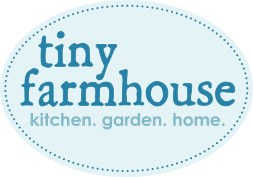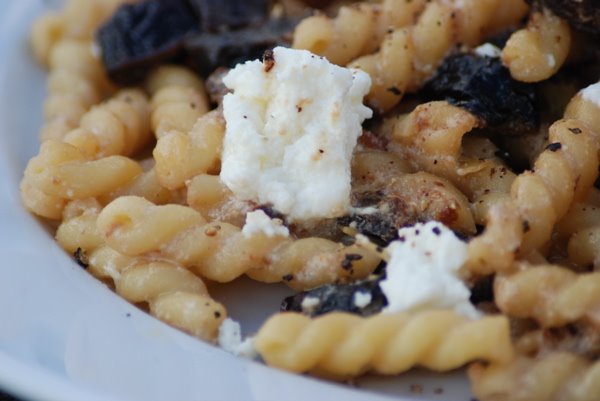Now, I realize that you might be reading this and thinking, “um, why, precisely, would I enjoy prunes in my pasta?” And I understand your skepticism. However, you must hear me out. I had a fantastic ricotta and prunes pasta dish for the first time a few years ago in Italy. So fantastic that while I ate it, I committed to making it at home one day. It was the day before my thirty-sixth birthday – “a monumental landmark birthday,” JR kept reminding me, quite facetiously – and we had stopped for lunch in a Tuscan spa town. Spas are a big thing in Italy, as far as I can tell. Generally, they involve naturally warm, mineral-rich waters which are fed into some sort of communal pool, and those waters are ascribed healing properties. The primary healing property I’ve heard about is the cleansing of the liver, which may explain why I saw so many bathing-suit-clad, flip-flop-wearing Italians running for the pools, arms heavy with towels and bottles of wine. It’s the Italian version of push-pull. In with the liver-damaging alcohol, and also in with the liver-restoring spa water. Let them duke it out, and with luck, the liver comes out unscathed. JR and I skipped the bathing, and instead had food to help offset the effects of the wine. Possibly not as curative as the healing waters, but it worked for us, as it has many times over.
It took a couple of years for me to get around to finally making pasta with prunes. I think I was stymied by JR’s inevitable scrunched up nose at the mention of pasta with prunes, but then one day, just a few months ago, the time seemed right. I had some leeks from the last day of my garden – and by some, I mean approximately a million – that needed to be used. Though there weren’t leeks in the Italian spa-town rendition of ricotta and prunes, I thought the sweetness of the leeks would work well with the prunes. And it did. It worked so well, in fact, that JR ate all of his and didn’t complain or scrunch his nose when I served it again a week later. And on that second night of pasta with prunes, he said – and I kid you not – “kinda tastes like meat.” OK?
The last time I made this dish, I arrived home from the grocery store with three bags of goods to put away and a drying rack full of dishes on the counter – you may know that I am cursed by the space restrictions of my minuscule kitchen and therefore do not have a dishwashing machine, I am the dishwasher. So I arrive home with both groceries and dishes needing to be put away. I put the pot of water on the burner at six minutes past the hour, put the groceries and dishes in their appropriate homes, prepped the leek and prunes while the water came to a boil, and we were eating forty minutes later. I suppose if I had brought the water to a boil more quickly, I could call this a 30-minute meal or some such, but it took until 46 past the hour to hoist a ricotta-and-prune-laden fork to my mouth, and so it likely will for you as well.
Ingredients
- 3-4 tablespoons olive oil
- 1/2 cup chopped leek, white and green parts only. The white and light green parts of a medium-sized leek will get you pretty close to a half-cup
- 12 ounces pitted prunes
- (1) 1-pound box of medium-length, thick pasta, such as Gemelli
- 1/2 cup fresh ricotta, plus an additional 1/4 cup to be divided evenly among the plates before serving
- salt and pepper
Instructions
- Bring pasta water to a boil over medium-high heat. While the water comes up to the boil, rinse and chop the leek, being sure to clean it of all dirt. Leeks are notorious for hiding dirt in their layers. Chop the prunes into 3-4 pieces per each.
- Once the water is boiling, salt and add pasta, cooking to the manufacturers instructions.
- In a large skillet, heat olive oil over medium heat, and add the leeks. Cook leeks alone in the pan for approximately 5 minutes. Add prunes, and continue to cook until pasta is al dente (cooked through, but firm to the bite). Add cooked pasta and 1 cup pasta cooking water to the skillet. Stir to combine and simmer for one minute. Add 1/2 cup fresh ricotta and stir until ricotta has melted. Salt and pepper to taste. Remove from heat and serve at once. Top each of the plates with a tablespoon or so of fresh ricotta and additional pepper if desired.
For a quick cost analysis on this quick meal, it cost $7.84 to make this for four people. The ricotta is your big-ticket item at $3.99 for 8 ounces. You’re using around 6 ounces, so that’s $3.00. The pasta was Barilla Gemelli, which cost $1.39 for the 1-pound box. I used Sunkist pitted prunes which cost $3.99 for 16 ounces, you’re using 12 ounces, so that’s $3.00. The olive oil is around 11-cents per tablespoon ($7.99 for 67 tablespoons using the Whole Foods store brand), so 45-cents, let’s say, and we don’t count salt and pepper. Inexpensive, quick to prepare, and a good conversation starter to boot. “Hey, how about this? My kids ate prunes in their pasta last night.” See where that takes you, alright?
Dinner tonight: Ribollita, the Tuscan bean and vegetable soup that is one of the staples of cucina povera, or peasant cooking. I made this last week as well, but it wasn’t quite as thick as I would have liked, so I’m making it once more to hopefully get it right. Estimated cost for two: $2.96. The beans were around $1.00 in the bulk section at Whole Foods, which is a quarter less than what I paid for beans the week before at the Providence Winter Farmers Market. The celery, onion, and two carrots were no more than a dollar. The leeks were $1.75. The garlic was 12-cents if you consider it was less than a quarter of the 50-cent head of garlic. The can of tomatoes was $1.67. I did buy bread because it was so darned good the last time, so we’ll use about a quarter of a loaf that cost $3.39. That’s 85-cents. The bread is toasted, then rubbed with garlic and placed at the bottom of the bowl of soup to make one bad-ass garlicky crouton. The cavolo nero, or dinosaur kale, was $2.49. This recipe yields 6 servings at a cost of $8.88, for a grand total of $1.48 per person.


Prunes are the bomb! I’m a huge fan of this prune dish. Throw it all in a zip loc bag to marinate. Bake then serve over rice or pasta. Shhhh. No one I’ve served it to knows there are prunes in it!
Mirabella Chicken
2 tablespoons dried parsley
1/2 cup white wine
1/4 cup olive oil
1/4 cup red wine vinegar
1/2 cup green olives, chopped
1/2 cup dried prunes, chopped
1/2 cup brown sugar, packed
2 teaspoons dried oregano
4 teaspoons garlic, chopped
1/4 cup capers
3 bay leaves
6 boneless skinless chicken breasts
Directions
Combine all ingredients and place in a freezer bag.
When ready to serve, defrost and bake covered at 350 degrees until chicken is done (30-40 mins?).
Sweet, Lis! I like the Mirabella Chicken as well, and it’s a good way to sneak in those prunes! Love it! YAY prunes!